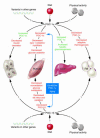Genes and pathophysiology of type 2 diabetes: more than just the Randle cycle all over again
- PMID: 15545992
- PMCID: PMC525752
- DOI: 10.1172/JCI23586
Genes and pathophysiology of type 2 diabetes: more than just the Randle cycle all over again
Abstract
The Randle cycle, which has been invoked to explain the reciprocal relationship between fatty acid oxidation and glucose oxidation, has long been implicated as a potential mechanism for hyperglycemia and type 2 diabetes mellitus (T2DM). Now genetic, functional genomic, and transgenic approaches have identified PPARgamma coactivators (PGC-1alpha and PGC-1beta) as key regulators of mitochondrial number and function. They regulate adaptive thermogenesis as well as glucose and fat oxidation in muscle and fat tissue, gluconeogenesis in liver, and even glucose-regulated insulin secretion in beta cells. PGC-1alpha and PGC-1beta mRNA levels and the mitochondrial genes they regulate are decreased in muscle of people with prediabetes and T2DM. A new report indicates that PGC-1alpha and PGC-1beta mRNA levels decrease with age in individuals with a genetic variant in PGC-1alpha, and these decreases correlate with alterations in whole-body glucose and fatty acid oxidation. These findings provide insights into how aging modifies genetic susceptibility to alterations in oxidative phosphorylation and T2DM.
Figures

Comment on
-
Multiple environmental and genetic factors influence skeletal muscle PGC-1alpha and PGC-1beta gene expression in twins.J Clin Invest. 2004 Nov;114(10):1518-26. doi: 10.1172/JCI21889. J Clin Invest. 2004. PMID: 15546003 Free PMC article.
References
-
- Elbein SC. Perspective: the search for genes for type 2 diabetes in the post-genome era. Endocrinology. 2002;143:2012–2018. - PubMed
-
- Horenstein RB, Shuldiner AR. Genetics of diabetes. Rev. Endocr. Metab. Disord. 2004;5:25–34. - PubMed
-
- Fajans SS, Bell GI, Polonsky KS. Molecular mechanisms and clinical pathophysiology of maturity-onset diabetes of the young. N. Engl. J. Med. 2001;345:971–980. - PubMed
-
- Huopio H, et al. A new subtype of autosomal dominant diabetes attributable to a mutation in the gene for sulfonylurea receptor 1. Lancet. 2003;361:301–307. - PubMed
Publication types
MeSH terms
Substances
LinkOut - more resources
Full Text Sources
Other Literature Sources
Medical

